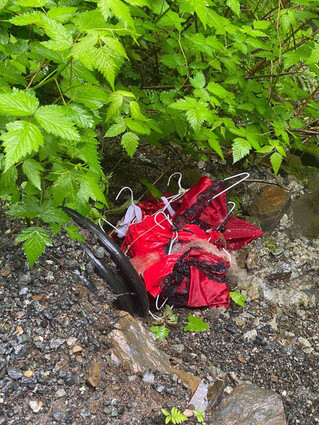Alaska Red Dress Installation For MMIP Damaged
Crafted by the Ketchikan Indian Community (KIC), an evocative installation emerged at Ward Lake in Southeast Alaska's Revillagigedo Island. Consisting of 60 red dresses elegantly suspended from trees, this powerful exhibit symbolized the missing or murdered Indigenous individuals from Ketchikan, Saxman, Prince of Wales Island, and Metlakatla.
Commencing on May 15, the installation stood as a tribute during MMIP (Missing and Murdered Indigenous People) Awareness Month, operating under a permit granted by the U.S. Forestry Service. However, as the installation's scheduled conclusion approached on May 31, distressing reports emerged-48 of the dresses had vanished without a trace. Disturbingly, social media platforms began showcasing photographs in recent days, revealing some of the dresses crumpled along the lakeside trail, partially buried, or callously abandoned near drain pipes.
"It's just disrespectful," Michael Toole, Ketchikan Indian Community's victim services program coordinator, told KRBD. "It's a terrible way to discount the reality of the lives of some of these people who were missing relatives who haven't received justice."
The tribal council released a declaration denouncing "a hurtful and disrespectful act that undermines the endeavors to foster understanding and increase awareness of the MMIP crisis."
Throughout May, similar installations are showcased across Canada and the United States, intending to shed light on the excessive number of Indigenous individuals who become victims of violent crimes or disappear.
According to the Centers for Disease Control and Prevention, homicide ranks as the third most common cause of death among Native women, and the murder rate for those living on reservations is a staggering ten times higher than the national average. In 2021, Alaska registered 229 cases of missing and murdered Indigenous people - 149 missing and 80 murdered.
Gloria Burns, Vice President of KIC and Chair of the Social Services Committee, conveyed to local radio station KRBD that the tribe intentionally displayed the dresses as a symbol of remembrance and purpose, with the goal of creating a "safe space."
"And so, in the midst of trying to establish a safe space, when it's deliberately made to feel unsafe, it very much feels like a violation," Burns told KRBD. "I believe the challenging part is that the issue of missing and murdered indigenous people has been ongoing since colonization, but it's a topic we have largely left unaddressed. We have really not communicated these issues to the wider community."





Reader Comments(0)